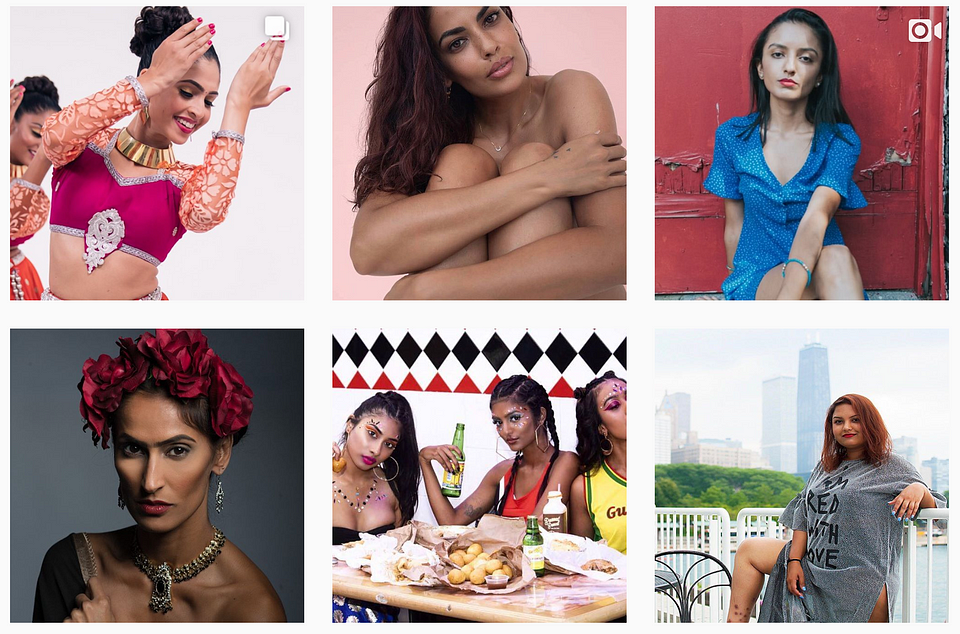The issue of representation — in media, entertainment, business, and politics — has finally become a hot topic in the US, bringing hope to marginalized communities that historically haven’t seen their experiences or needs reflected, well, anywhere. One of these populations is the South Asian diaspora, of which I myself am a part. The needle has begun to move, particularly in Hollywood: from Aparna Nancharla to Hasan Minhaj to Hari Kondabolu to Mindy Kaling and beyond, the roster of first-generation and immigrant South Asian Americans who have marched into mainstream consciousness is growing steadily. With this increased (or rather, newfound) visibility and sense of confidence, members of the diasporic community are beginning to carve out spaces to come together and speak up.
One such space is Brown Girl Magazine, an online publication for members of the South Asian diaspora. On any given day, the site features articles ranging from “5 of the Biggest South Asian Skincare Myths we all Believe” to “Suicide in South Asian Cinema: Romanticized or Reality?” to “Indian vs. American: Dealing With a Cultural Identity Crisis”, and everything in between (including an entire section devoted to Colonial Effects — be still, my beating heart).
Early on the Monday following Thanksgiving weekend, I get on the phone with Trisha Sakhuja-Walia, CEO of Brown Girl Magazine, to talk about her path and vision for the platform. She’s in between meetings, her schedule already jam-packed at 8 AM, but her voice carries a cool, collected calmness I can sense through the phone. Knowing I only have 30 minutes of her time, I get right to it.
Brown Girl Magazine was founded in Texas in 2008 by Aditi Mehta, intended to be a feminist platform for young South Asian women living in the United States. Since then, the site’s audience has expanded across gender identities, age groups, and geographies. Trisha joined the team in 2011 and has been an integral part of Brown Girl Magazine’s growth and evolution since. She explains that while the empowerment of South Asian-American women has always been a vital component of the publication’s mission, Brown Girl Mag began to broaden its scope after identifying segments of its readership that transcend these parameters.


“After we started using Google Analytics, we were like wait a minute — we’re seeing traffic from Canada, the UK, Australia, and India,” Trisha explains. “Then we realized people above the age of 24 are reading our website. Then we realized 35% of our traffic is male. So we’re expanding to South Asian people as a whole. It’s all about evolving with the times, and understanding what needs we’re fulfilling and what needs we can fulfill better.”
Though Trisha began her journey with Brown Girl Magazine as an undergraduate at Stonybrook University, it only recently became her full-time focus. Her involvement started with an article for a journalism class project, but it wasn’t long before it evolved into a leadership position. “I never realized I could love a website as much as I started to love it, so I started asking original founder what more I could do. First I recruited writers in the New York area. Then I helped the social media team become more active on Twitter and Instagram. I just started organically doing things at Brown Girl, and little by little it all fell into place,” she reflects. “I realized then that Brown Girl had so much potential — I never saw Brown Girl for what it was. I always saw it for what it could be.”
Trisha’s capacity for leadership and her passion for the Desi (a term that loosely encompasses people/things from the Indian subcontinent and its diaspora) community stemmed from her experiences growing up in the suburbs of NYC. “I co-created the first-ever Desi club at my high school. It was in the early 2000s when Desis weren’t really on the map, so to start a Desi club was out of the ordinary,” she says. “But for a while, believe it or not, my friends and I were going to the Greek club. That was the closest thing we had to our skin color, and it was silly.”
After liaising with her school’s administration, she successfully founded and spearheaded the organization. Moving into college, she took on leadership roles within Stonybrook’s South Asian Student Association (SASA). Little did she know that in taking these actions, she was laying the foundation for her future as a leader in the community at large.

Like many, Trisha entered the corporate world after school while continuing her passion-fueled side hustle with Brown Girl Magazine. She spent almost four years working in editorial content management at Zee TV, an Indian cable TV network. Luckily, not only did she thoroughly enjoy this day job, but it allowed for some overlap with her role at BGM. “I had a team of 30 editors and freelancers [at Zee TV]. I was able to understand what it meant to run a team and curate content and make sure we were getting the numbers we needed,” Trisha says. “My time at Zee helped me envision going full-time with Brown Girl was a possibility. But I still never thought it would be a reality. I wished I could do it, I just didn’t know how.”
Then, in 2017, she got married. As independent as she is, having a partner with a stable income quelled some of Trisha’s concerns about exiting the comfort zone and dedicating herself to Brown Girl Mag: “When you want to take a gigantic risk and work on something that is not fully sustainable yet, you need some backing from a partner, your parents, or your savings. In my case, getting married really helped.” She swiftly began internal negotiations and, despite those residual fears, eventually bought out her business partners’ shares. The prevailing narrative surrounding young South Asians who pursue non-traditional careers involves dramatic acts of anger and disownment, so I was pleased to hear that Trisha’s family, friends, and colleagues supported her decision wholeheartedly (“I’d been talking about Brown Girl for years — I think everyone was just like, finally, *she’s doing it”).*
Though it’s only been a year with Trisha at the helm, the publication has accomplished big things, including hosting its first-ever conference for South Asian creatives in NYC, the Slashie Summit. But just as significant has been Trisha’s marked personal growth. She’s realized she can flourish through the rollercoaster ride of entrepreneurship, and she’s come into her own as a leader. “I was able to understand my own potential and hone in on the fact that I can do it all — as long as I have my teams in place, we can make the most unrealistic goals possible. And there is potential, there is opportunity here,” she says.
Establishing the company’s headquarters in New York City has been another pivotal aspect of its growth. Though Brown Girl Magazine works with writers across the country and internationally, being based in an urban cultural hub means that it always has a finger on the pulse of the latest trends and goings-on. “There are weeks where I’m going to five different events specifically for South Asians. Sometimes I have to step back and be like, wow. This is a privilege. And I cannot take it for granted because Brown Girl is only able to grow because we’re in New York. There are so many players in the community that care about us, respect us, and want us to be a part of what they’re doing. Being in NYC has been…everything.”

Brown Girl is building momentum after the success of October’s Slashie Summit. On Black Friday, they launched a line of “Ladki Power” (Ladki means girl in Hindi) shirts in partnership with Roots Gear Clothing Co, a marketplace for South-Asian inspired streetwear. Trisha is also excited to reveal Brown Girl’s first ever video-series next year — details to be announced soon (“Still figuring it out. I take my time with projects!”).
As a member of the community that Brown Girl Magazine is meant for, I hope that Trisha and Brown Girl inspire young people who identify with any marginalized group, reminding them that their voices are relevant and that they deserve a space for community, understanding, and collective healing. But Trisha’s path is also a reminder that it’s up to us — our communities, our people, across generations — to grab the reins and build these platforms together. Our society is ripe for innovation and expansion and evolution when it comes to representation and inclusivity, but no one is going to make it happen for us.
Trisha sums up Brown Girl Magazine’s potential best: “The opportunity for growth is vast. We haven’t even touched the surface yet. That’s why I continue to look at Brown Girl not as what it is today, but what it could be tomorrow.”
Snag a #LadkiPower t-shirt and visit Brown Girl Magazine for yourself! Share your thoughts by tweeting @nooklyn, reaching out on Facebook or finding us on Instagram @nooklyn.stories.
Photo Credits:
Portraits by Pooja Dhar
All other images pulled from Instagram